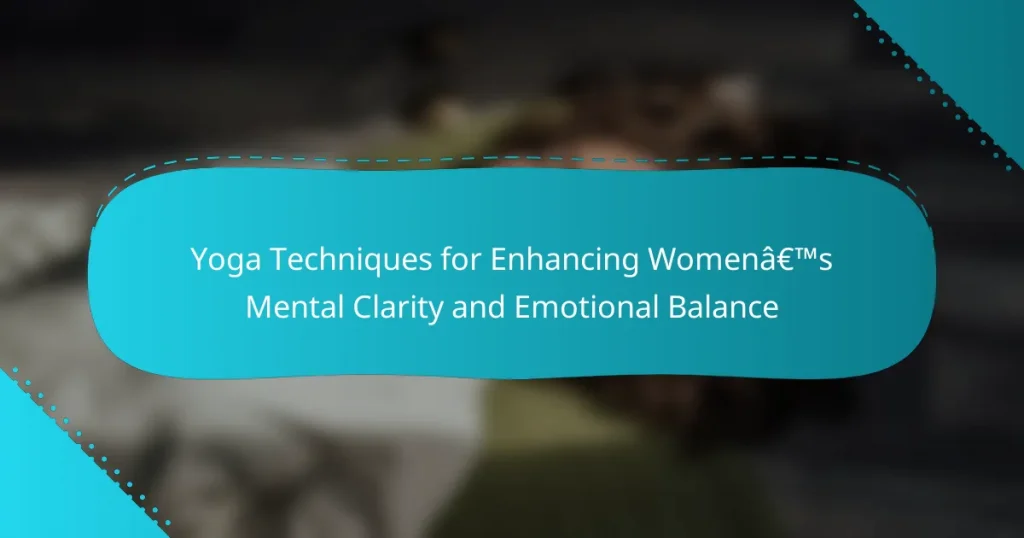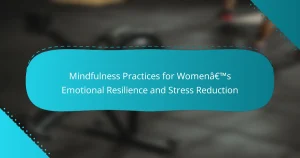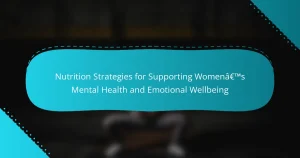Enhancing mental clarity and emotional balance is crucial for women’s well-being. This article explores yoga techniques, including mindfulness practices, breath control, and restorative poses. These methods foster self-awareness, regulate emotions, and promote relaxation, contributing to overall mental health. Additionally, regional practices offer tailored benefits that resonate with cultural backgrounds, enriching the yoga experience.
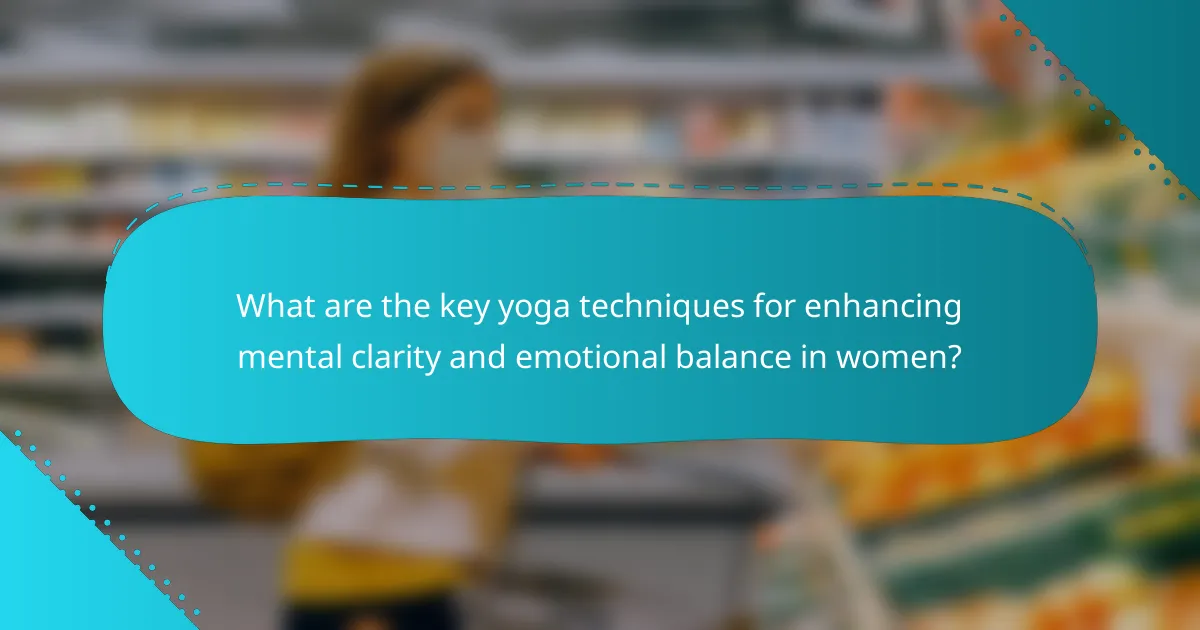
What are the key yoga techniques for enhancing mental clarity and emotional balance in women?
Yoga techniques that enhance women’s mental clarity and emotional balance include mindfulness practices, breath control, and restorative poses. Mindfulness meditation fosters self-awareness and reduces stress. Pranayama, or breath control, helps regulate emotions and increase focus. Restorative yoga poses promote relaxation and emotional stability, making them essential for overall well-being. These techniques collectively support mental clarity and emotional balance in women.
How does breath control impact mental clarity?
Breath control significantly enhances mental clarity by promoting relaxation and reducing stress. Techniques like pranayama in yoga increase oxygen flow to the brain, improving focus and cognitive function. Controlled breathing also activates the parasympathetic nervous system, which fosters emotional balance and mental stability. Regular practice can lead to lasting improvements in overall mental well-being.
What specific breathing exercises can be practiced?
Breathing exercises that enhance mental clarity and emotional balance include diaphragmatic breathing, alternate nostril breathing, and box breathing. These techniques promote relaxation and focus, supporting overall well-being.
Diaphragmatic breathing involves deep inhalations through the nose, expanding the diaphragm, followed by slow exhalations. Alternate nostril breathing balances energy and calms the mind by alternating breaths through each nostril. Box breathing consists of inhaling, holding, exhaling, and pausing for equal counts, fostering concentration and reducing stress.
How does breath awareness contribute to emotional balance?
Breath awareness significantly enhances emotional balance by fostering mindfulness and reducing stress. This practice allows individuals to connect with their emotions, promoting self-regulation and clarity. Regular breath awareness can lead to improved mental clarity, enabling better decision-making and emotional responses. As a result, practitioners often experience a greater sense of calm and emotional stability.
Which yoga poses are most effective for mental clarity?
Certain yoga poses significantly enhance mental clarity and emotional balance for women. Poses like Downward Dog, Child’s Pose, and Tree Pose promote relaxation and focus. These techniques stimulate blood flow to the brain, reduce stress, and improve concentration. Incorporating these poses into a daily routine can lead to lasting mental clarity and emotional stability.
What are the benefits of standing poses?
Standing poses in yoga enhance mental clarity and emotional balance by promoting focus and grounding. These postures engage the body, fostering stability and strength. As a result, practitioners experience improved concentration and reduced anxiety. Regular practice can lead to heightened self-awareness and resilience, essential for emotional well-being. Standing poses also improve posture and body alignment, contributing to overall mental clarity.
How do seated poses enhance focus?
Seated poses enhance focus by fostering stability and grounding the mind. These postures promote deep breathing, which increases oxygen flow to the brain, thereby improving concentration. Additionally, seated poses encourage mindfulness, allowing practitioners to remain present and aware, reducing distractions. Regular practice can lead to improved mental clarity and emotional balance, essential for overall well-being.
What role does meditation play in emotional balance?
Meditation plays a crucial role in achieving emotional balance by promoting mindfulness and reducing stress. Regular practice enhances self-awareness, allowing individuals to process emotions more effectively. Studies show that meditation can lower anxiety levels and improve overall mood, contributing to mental clarity. Additionally, unique techniques like loving-kindness meditation specifically foster compassion and emotional resilience, which are essential for emotional well-being.
Which meditation techniques are best suited for women?
Mindfulness meditation, guided imagery, and loving-kindness meditation are effective techniques for women. These practices enhance mental clarity and emotional balance, addressing unique stressors women may face. Mindfulness meditation promotes present-moment awareness, reducing anxiety. Guided imagery fosters relaxation and visualization, aiding emotional processing. Loving-kindness meditation cultivates compassion and self-acceptance, which are vital for emotional well-being. Each technique offers distinct benefits, supporting women’s mental health.
How can visualization enhance emotional stability?
Visualization enhances emotional stability by promoting mindfulness and reducing stress. Techniques such as guided imagery and visualization exercises can help women focus on positive outcomes and manage anxiety. Engaging in these practices regularly fosters a greater sense of control over emotions. Additionally, visualization can create mental clarity, enabling better decision-making and emotional balance in daily life.
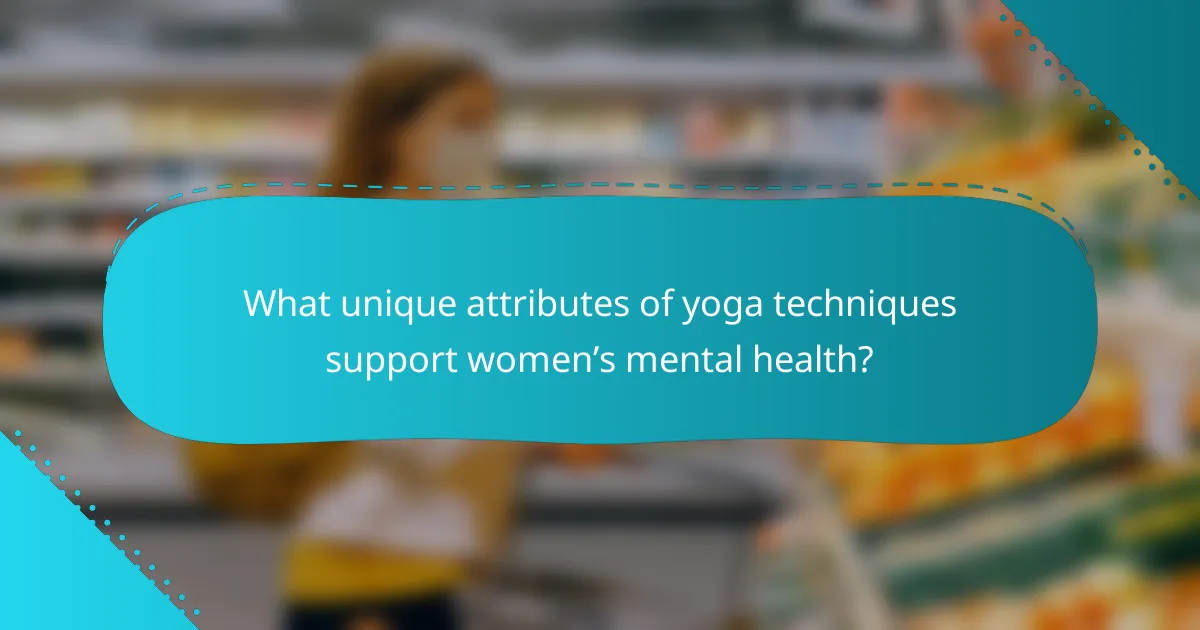
What unique attributes of yoga techniques support women’s mental health?
Yoga techniques uniquely support women’s mental health by enhancing emotional resilience and promoting clarity. Techniques such as restorative yoga focus on relaxation, reducing anxiety and stress. Mindfulness practices within yoga encourage self-awareness, enabling women to process emotions effectively. Breathing exercises, or pranayama, enhance oxygen flow, improving mental clarity and focus. Additionally, community aspects of yoga foster social connections, which are crucial for emotional well-being. These combined attributes create a holistic approach that addresses mental health challenges faced by women.
How do restorative yoga practices aid emotional regulation?
Restorative yoga practices enhance emotional regulation by promoting relaxation and mindfulness. These techniques reduce stress hormones, fostering emotional balance. Deep breathing and gentle stretches increase body awareness, allowing women to process emotions effectively. Research indicates that regular practice improves mood and reduces anxiety, supporting mental clarity.
What specific yoga styles cater to women’s mental clarity needs?
Hatha, Kundalini, and Yin Yoga are effective styles for enhancing women’s mental clarity. Hatha focuses on physical postures and breath control, promoting relaxation. Kundalini utilizes dynamic movements and meditation to awaken energy, fostering emotional balance. Yin Yoga involves deep stretching and mindfulness, encouraging introspection and mental calmness. Each style addresses unique aspects of mental clarity, making them suitable for women’s emotional needs.
How does Kundalini yoga differ in approach?
Kundalini yoga differs in approach by emphasizing the awakening of energy through specific techniques. It integrates breath control, meditation, and chanting to enhance mental clarity and emotional balance. This practice uniquely focuses on the spiritual aspect of yoga, aiming to raise consciousness and promote self-awareness. Unlike other yoga forms, Kundalini often incorporates dynamic movements and repetitive exercises, fostering a deeper connection to one’s inner self.
What are the unique benefits of Yin yoga for emotional balance?
Yin yoga uniquely enhances emotional balance by promoting deep relaxation and introspection. This practice encourages mindfulness, allowing individuals to process emotions effectively. The long-held postures facilitate a release of tension, which can lead to improved mental clarity. Additionally, Yin yoga’s focus on breath and stillness cultivates a sense of inner peace, making it a powerful tool for emotional stability.

What rare benefits can yoga techniques offer for women’s mental clarity?
Yoga techniques can enhance women’s mental clarity through unique practices that promote mindfulness and emotional balance. Techniques such as breath control and meditation foster introspection, reducing anxiety and improving focus. Specific styles like Kundalini yoga emphasize energy flow, which can lead to heightened awareness and cognitive clarity. Additionally, restorative yoga offers a rare benefit by facilitating deep relaxation, allowing for mental rejuvenation and clearer thinking. Regular practice can significantly contribute to improved emotional resilience and mental well-being in women.
How can yoga help in managing hormonal changes affecting mood?
Yoga effectively manages hormonal changes that affect mood by promoting relaxation and reducing stress. Techniques like deep breathing, mindfulness, and specific poses enhance mental clarity and emotional balance. Research indicates that regular yoga practice can lower cortisol levels, which helps stabilize mood swings. Additionally, yoga fosters a sense of community and support, further contributing to emotional well-being during hormonal fluctuations.
What lesser-known yoga practices promote emotional resilience?
Lesser-known yoga practices that promote emotional resilience include restorative yoga, yoga nidra, and laughter yoga. Restorative yoga emphasizes relaxation and deep stretching, enhancing emotional balance. Yoga nidra, or yogic sleep, fosters profound relaxation and mental clarity, aiding emotional regulation. Laughter yoga combines laughter exercises with yoga breathing, boosting mood and resilience. Each practice uniquely contributes to mental clarity and emotional stability.
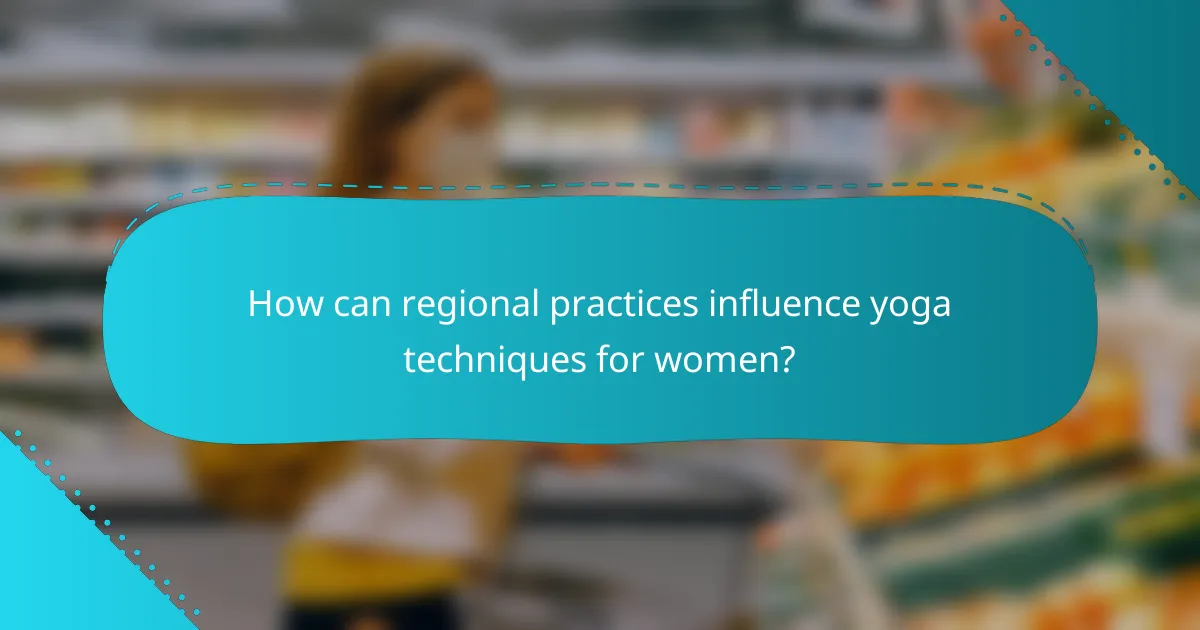
How can regional practices influence yoga techniques for women?
Regional practices significantly shape yoga techniques for women by integrating local cultural elements and addressing specific mental and emotional needs. For instance, practices in India often emphasize meditation and breath control, enhancing mental clarity. In contrast, Western approaches may focus on physical alignment and strength, promoting emotional balance. Unique attributes, such as regional breathing techniques or postures, can further influence these practices. As a result, women can experience tailored benefits that resonate with their cultural backgrounds, fostering a deeper connection to their yoga practice.
What cultural adaptations exist in yoga for mental clarity?
Cultural adaptations in yoga for mental clarity include various techniques tailored to enhance emotional balance for women. Practices such as mindfulness meditation, breath control (pranayama), and specific asanas are emphasized. Mindfulness meditation promotes present-moment awareness, reducing anxiety. Pranayama techniques regulate breath, fostering calmness and focus. Certain asanas, like Sukhasana and Balasana, are designed to ground emotions and enhance mental clarity. These adaptations reflect unique cultural influences, integrating traditional practices with contemporary needs for mental health.
How do local community classes enhance emotional support?
Local community classes enhance emotional support by fostering connections among participants. Engaging in yoga techniques promotes mental clarity and emotional balance, creating a safe space for women to share experiences. This shared environment often leads to increased empathy and encouragement, reinforcing emotional resilience. Furthermore, studies indicate that social support significantly reduces stress levels, contributing to overall mental well-being.

What are the best practices for integrating yoga into daily life for mental clarity?
Integrating yoga into daily life enhances mental clarity through consistent practice and mindfulness. Start with short sessions, focusing on breath and meditation. Establish a routine by dedicating specific times for yoga each day. Incorporate mindfulness techniques during daily activities, promoting awareness and emotional balance. Utilize yoga’s unique attributes, such as asanas and pranayama, to alleviate stress and enhance focus. Regular practice can lead to significant improvements in mental clarity and emotional stability, making yoga a valuable tool in daily life.
How can women create a personalized yoga routine?
Women can create a personalized yoga routine by identifying their specific mental clarity and emotional balance goals. Start by assessing personal needs, such as stress relief or focus enhancement. Incorporate a variety of techniques like breathwork, meditation, and specific asanas that resonate with these goals.
For example, integrating poses like Child’s Pose or Forward Bend can promote relaxation and introspection. Consistency is key; aim for a regular practice schedule that fits your lifestyle. Additionally, consider using guided sessions or apps tailored for women’s wellness to enhance the experience.
Finally, reflect on progress and adjust the routine as necessary to ensure it continues to meet evolving needs. This personalized approach fosters a deeper connection to mental clarity and emotional stability through yoga.
What common mistakes should be avoided in yoga practice?
Avoiding common mistakes in yoga practice enhances mental clarity and emotional balance. Key errors include neglecting proper alignment, pushing beyond personal limits, and skipping breath awareness.
1. Ignoring Alignment: Poor alignment can lead to injury and disrupt the flow of energy, reducing the practice’s benefits.
2. Overexertion: Practicing beyond comfort can cause physical strain and mental stress, counteracting emotional balance.
3. Lack of Breath Focus: Breath awareness is essential for grounding and centering, which supports mental clarity.
4. Skipping Warm-ups: Inadequate preparation can lead to stiffness and hinder performance, affecting overall practice.
5. Distractions: Practicing in a chaotic environment can diminish focus and reduce the effectiveness of the session.
By addressing these mistakes, practitioners can cultivate a more beneficial yoga experience.
What expert insights can enhance the effectiveness of yoga for emotional balance?
Expert insights suggest that specific yoga techniques can significantly enhance emotional balance. Incorporating mindfulness practices within yoga, such as breath control and meditation, fosters mental clarity. Research indicates that regular yoga sessions can reduce anxiety levels by up to 30%.
Additionally, focusing on restorative poses helps in alleviating stress and promoting relaxation. Unique attributes like the use of intention setting before practice can further deepen emotional awareness. As a result, practitioners often report improved mood and emotional resilience.
